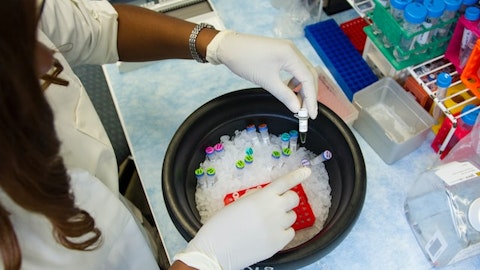Scott Braunstein: Joe, let me kick it off, and then I’ll pass it over to you for the trial design. Jason, what we’re really thinking is that this will be a ZTALMY study. And I think, quite honestly, five years ago, I would have felt crazy to run this study. But given now what we understand about ZTALMY, the PK, the PD, the blood levels. And what we’ve seen over the years a consistent improvement in serum concentrations of the drug. And by the — and when we finish the TSC study, we’ll be happy to share some of the — we haven’t seen the blood levels in TSC, but we’ve seen them in other healthy volunteer studies or SAD, MAD studies — and certainly, we’re feeling good about the discontinuation rates in the real world. So I have a heck of a lot more confidence today that in any study with ZTALMY, we can get the vast majority of patients to a therapeutic blood level.
And I think our goal in this study is to really show that proof of concept, and I’ll let Joe talk about it. I think what we also want to walk away is where do we think ganaxolone as a molecule is most effective it’s not only in LGS, but in other refractory DEs, but I would not expect this study that we will kick off to really include that second gen. We’ll use this study to help guide us on efficacy and where we want to go with the pivotal. And we’ll take the next gen through the SAD, MAD studies and hopefully, those will align in terms of what we want to do with the prodrug program. And I think we have the luxury of a little time to get this right, to be thoughtful. We’ve got two launches that we’ll be planning for in ’25. So that will keep us pretty busy.
And — but that being said, I think — there are not a lot of folks who are really thinking about these patients, and it is a priority for us to get there. Joe, you want to talk a little bit more about the trial design? What you’re thinking about the trial design?
Joseph Hulihan: Yeah. So again, this would be the initial trial is proof-of-concept, single arm, open label. We have not yet done the detailed discussions about what statistical signal we want to see to say the drug is particularly effective in condition X. I mean I think there are a lot of things we can get out of such a study besides signal finding. I mean we look at signals based on the genetic etiology, seizure phenotype, the type of seizure. We can also get information on non-seizure outcomes, some preliminary PK/PD data and also information to inform other pieces of a study design, selection of the clinical endpoints, even how we collect the data, how we do the measurements. And a basis for statistical — more than statistics within the study itself, a basis for statistical powering on any subsequent study we would do.
The general comment would be if everything — if overall, we get a good effect and every subset seems to be trending in the same direction that will tell us one thing, but if something happens to pop, we may get patients in the study with specific disorders of GABAergic transmission that may show a differential effect. All of those things will be informative. In terms of how much of a signal, I don’t think we haven’t done the statistical powering on that yet. A lot of the statistical descriptions in the study will be truly descriptive statistics without a priority statistical powering.
Scott Braunstein: Thanks for the question. Operator, we’re going to take one more question from the call in, and then we’re going to have to cut the call.
Operator: Thank you. We will take our final question from Brian Skorney with Baird. Your line is open.
Brian Skorney: Hi. Good afternoon, guys. I just wanted to ask a question also on RAISE sort of the powering assumptions that it is originally powered for 40% health and I think you’ve been talking about as low as 30% delta to reach stat. So, I’m just wondering how to trying to think about that 30% delta. Is that based on blinded response rates overall in the study, just kind of going through the powering analysis. And how different results wind up hitting stats, so at 83 patients. So, I don’t know, is that informed at all by a blinded analysis? Or is that consistent with the original analysis? And can you review any of the statistical assumptions underpinning the time-to-cessation analysis. That’s a secondary endpoint since it’s not binary outcome? Just what sort of separation you need to see there to be statistic? Thanks.
Scott Braunstein: Joe, let me kick off and then I’ll turn it over to you. So Brian, we have not looked at the blinded data. It’s had no impact on our decision-making here. I think when we started the study, we really could not get a very comfortable handle on where placebo rates would be in the study. I think it was very clear enough. So once we started the study and we added a protocol amendment, and we had our physicians really screening every patient — our confidence continues to grow that we were seeing a highly refractory population that was very likely going to have a low placebo rate. We’ve shared with you that blinded data that the average patient in this study is not — it’s failing 3.5 drugs. 3.5 drugs. They are being observed for 24 hours compared to about eight hours for our Phase 2, and giving us a lot of confidence that physicians have run out of options.
And our clinical team has pressed every enrollment every physician on enrollment making it crystal clear that if a patient wants to be enrolled, the physician had to feel comfortable that IV anesthetic was an extra of choice. Now that being said, there are still going to be some placebo patients that probably or drug patients that still are having epileptic form activity and are not getting IV anesthesia. Physicians are not perfect beasts, but we feel quite confident that the placebo rate will come in lower than our original assumption of 30% to 40%. I don’t think we had any magical way to really think about that when the study started, given that the only publication suggested about a 9% response rate in third-line patients. So I think we have just seen this patient — this study progressed.
We feel very good about it. We feel that we’re likely overpowered for a 40% delta where we were and we think for the interim analysis, these 83 patients will be more than sufficient. Joe, do you want to talk about the secondaries and then we’re going to wrap.
Joseph Hulihan: Yeah, yeah, just real quick about — I mean, the power calculation, the hardest data we had was from a survey of the investigators. When they — besides when we presented them with the profile based on the inclusion criteria, they said that they would advance to IV anesthesia 70% of the time within two hours. And so 70% advance, that gives the 30% not advanced, there’s there would be basically what we would translate to the placebo rate, 30%, 35%. In terms of the secondaries, the time to status cessation, we expect that actually to be — it’s a continuous variable, so even more robust than the responder analysis on the primary. And the way status would stop in the Phase 2, it was a median of five minutes in the ganaxolone group.
Patients in the placebo group aren’t going to stop spontaneously. When they’ll stop, it’s when they’re treated. And so that’s going to be a period of hours probably in most cases. And so that continuous variable is extremely robust in terms of statistical power.
Brian Skorney: Great. Thanks a lot.
Operator: And ladies and gentlemen, that is all the time we have for questions today. This will also conclude today’s call. We thank you for your participation. And you may now disconnect.



